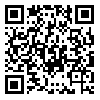Volume 15, Issue 3 (Occupational Medicine Quarterly Journal 2023)
tkj 2023, 15(3): 53-66 |
Back to browse issues page
Ethics code: IR.IAU.KHUISF.REC.1399.128
Download citation:
BibTeX | RIS | EndNote | Medlars | ProCite | Reference Manager | RefWorks
Send citation to:



BibTeX | RIS | EndNote | Medlars | ProCite | Reference Manager | RefWorks
Send citation to:
Soltani M, Farhadi H, Manshaee G, Mahdad A. The effectiveness of virtual reality exposure therapy and comparing its effectiveness with mindfulness-based stress reduction of job stress and its components in employees with job stress. tkj 2023; 15 (3) : 6
URL: http://tkj.ssu.ac.ir/article-1-1230-en.html
URL: http://tkj.ssu.ac.ir/article-1-1230-en.html
Department of Educational Science and Psychology, Isfahan (khorasgan) Branch, Islamic Azad University, Isfahan, Iran. , Farhadihadi@yahoo.com
Abstract: (1471 Views)
Introduction: job stress is defined as the accumulation of stressful factors in job-related situations, which most people agree is stressful, and it can be the direct factor in the intention to leave the job. The present study investigates the effectiveness of virtual reality exposure therapy and compares its effectiveness with mindfulness-based stress reduction based on mindfulness on the components of job stress employees with job stress.
Materials and Methods: The research design was a semi-experimental pre and post-test with a control group and a follow-up phase. The statistical population included all employees with job stress in a private company in Isfahan City in 2022, and the research sample included 45 employees who were randomly divided into three groups of 15: virtual reality therapy, mindfulness-based stress reduction therapy, and Controls were replaced. The people of the two intervention groups participated in the intervention sessions; The first experimental group underwent eight 20-minute weekly sessions of virtual reality therapy, and the second experimental group underwent eight weekly 45-minute sessions based on the Kabat-Zin training package (1990 and 2013), but for the control group no interventions were performed. The participants responded to the occupational stress questionnaire of the Health and Safety Institute of England Steinmetz (HSE) (1990) in three stages. The research data were analyzed with analysis of covariance and Bonferroni's post hoc test and using SPSS23 statistical software at two descriptive and inferential levels.
Results: The results of covariance analysis and Bonferroni's post hoc test indicated that both intervention methods equally and effectively reduced occupational stress in the fields of role, communication, support of colleagues, changes in employees, and the effect of both interventions remained stable over time (P<0.01). Although both methods of intervention reduced the pressure and job stress of employees, and the components of stress include support, control, and demand from officials, and its effect remained constant over time, virtual reality treatment was more effective in both stages (P>0.05).
Conclusion: The results showed that virtual reality courses and stress reduction based on mindfulness can reduce the tensions and job stress of personnel and employees of organizations.
Materials and Methods: The research design was a semi-experimental pre and post-test with a control group and a follow-up phase. The statistical population included all employees with job stress in a private company in Isfahan City in 2022, and the research sample included 45 employees who were randomly divided into three groups of 15: virtual reality therapy, mindfulness-based stress reduction therapy, and Controls were replaced. The people of the two intervention groups participated in the intervention sessions; The first experimental group underwent eight 20-minute weekly sessions of virtual reality therapy, and the second experimental group underwent eight weekly 45-minute sessions based on the Kabat-Zin training package (1990 and 2013), but for the control group no interventions were performed. The participants responded to the occupational stress questionnaire of the Health and Safety Institute of England Steinmetz (HSE) (1990) in three stages. The research data were analyzed with analysis of covariance and Bonferroni's post hoc test and using SPSS23 statistical software at two descriptive and inferential levels.
Results: The results of covariance analysis and Bonferroni's post hoc test indicated that both intervention methods equally and effectively reduced occupational stress in the fields of role, communication, support of colleagues, changes in employees, and the effect of both interventions remained stable over time (P<0.01). Although both methods of intervention reduced the pressure and job stress of employees, and the components of stress include support, control, and demand from officials, and its effect remained constant over time, virtual reality treatment was more effective in both stages (P>0.05).
Conclusion: The results showed that virtual reality courses and stress reduction based on mindfulness can reduce the tensions and job stress of personnel and employees of organizations.
Article number: 6
Keywords: Virtual Reality Exposure Therapy, Mindfulness-Based Stress Reduction, Job Stress, Employees
Type of Study: Research |
Subject:
General
Received: 2023/02/12 | Accepted: 2023/06/2 | Published: 2023/10/8
Received: 2023/02/12 | Accepted: 2023/06/2 | Published: 2023/10/8
Send email to the article author
| Rights and permissions | |
 |
This work is licensed under a Creative Commons Attribution-NonCommercial 4.0 International License. |







